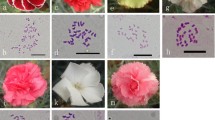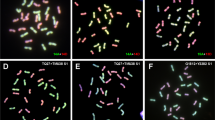Abstract
Cytogenetical studies were carried out on the successive generations of offsprings from the induced tetraploid hybrid (2n = 32) betweenRanunculus silerifolius (2n = 16) andR. chinensis (2n = 16). Aneuploids, 2n = 30 to 35, frequently occurred. In latter subsequent generations the deviation of aneuploids increased, but the proportion of euploids decreased, accompanied by the reduction of fertility of pollen grains and seed sets. F2 and F4 PMCs constantly exhibited meiotic abnormality, i.e. formation of quadrivalents and univalents. The speciation process ofR. cantoniensis (2n = 32), which was presumed to arise from tetraploid hybrids between the above two species, is discussed on the basis of the above evidences.
Similar content being viewed by others
References
Evans, G. M., Davies, E. W., 1982: The dynamics of aneuploid in an induced tetraploid population ofLolium multiflorum ×Lolium perenne. — Theor. Appl. Genet.62: 39–44.
—, —, 1983: Fertility and stability of induced polyploids. — InBrandham, P. E., Bennett, M. D., (Eds.). Kew Chromosome Conference 2, pp. 139–146. — London: Her Majesty's Stationery Office.
Fujishima, H., 1984: Geographical distribution ofRanunculus silerifolius Lèv. (2n = 16) andR. cantoniensis DC. (2n = 32) in the Matsuyama district. — Fac. Educ. Tottori Univ.33: 45–48.
Gilles, A., Randolph, L. F., 1951: Reduction of quadrivalent frequency in autotetraploid maize during a period of ten years. — Amer. J. Bot.38: 12–17.
Grant, V., 1981: Plant speciation. 2nd ed. — New York: Columbia University Press.
Müntzing, A., 1932: Cytogenetic investigations on the syntheticGaleopsis tetrahit. — Hereditas16: 105–154.
Newton, W. C. F., Pellew, C., 1929:Primula kewensis and its derivatives. — J. Genet.20: 405–467.
Okada, H., 1984: Polyphyletic allopolyploid origin ofRanunculus cantoniensis (4x) fromR. silerifolius (2 x) ×R. chinensis (2 x). — Pl. Syst. Evol.148: 89–102.
—,Tamura, M., 1977: Chromosome variations inRanunculus quelpaertensis and its allied species. — J. Japan. Bot.52: 360–369.
Stebbins, G. L., 1984: Polyploidy and the distribution of the arctic-alpine flora: new evidence and a new approach. — Bot. Helvetica94: 1–13.
—, 1985: Polyploidy, hybridization, and the invasion of new habitats. — Ann. Missouri Bot. Gard.72: 824–832.
Author information
Authors and Affiliations
Additional information
Former contributions of this series areOkada & Tamura (1977) andOkada (1984).
Rights and permissions
About this article
Cite this article
Okada, H. Cytogenetical changes of offsprings from the induced tetraploid hybrid betweenRanunculus silerifolius (2n = 16) andR. chinensis (2n = 16) (Ranunculaceae). Pl Syst Evol 167, 129–136 (1989). https://doi.org/10.1007/BF00936401
Received:
Revised:
Issue Date:
DOI: https://doi.org/10.1007/BF00936401




